O'Meara Electronics: Analysis of Remuneration and Performance
VerifiedAdded on 2023/06/14
|11
|3049
|391
Case Study
AI Summary
This case study examines the remuneration and performance management strategies at O'Meara Electronics, an Australian electronics company facing declining profitability. The company is considering a shift from a position-based to a person-based remuneration system and has hired an HR consultant to advise on the best approach. The analysis covers position-based and person-based systems, their advantages and disadvantages, and the key drivers of different remuneration strategies. The study employs analytical and critical approaches to assess the situation, ultimately recommending a hybrid remuneration system that combines elements of both position-based and person-based approaches to improve employee motivation, performance, and the company's overall market position. The report concludes that such a system is the optimal solution for addressing the challenges faced by O'Meara Electronics.

Running head: ADVANCED REMUNERATION AND PERFORMANCE
Advanced Remuneration and Performance: The O’Meara Electronics Company
Name of the Student
Name of the University
Author’s Note:
Advanced Remuneration and Performance: The O’Meara Electronics Company
Name of the Student
Name of the University
Author’s Note:
Paraphrase This Document
Need a fresh take? Get an instant paraphrase of this document with our AI Paraphraser
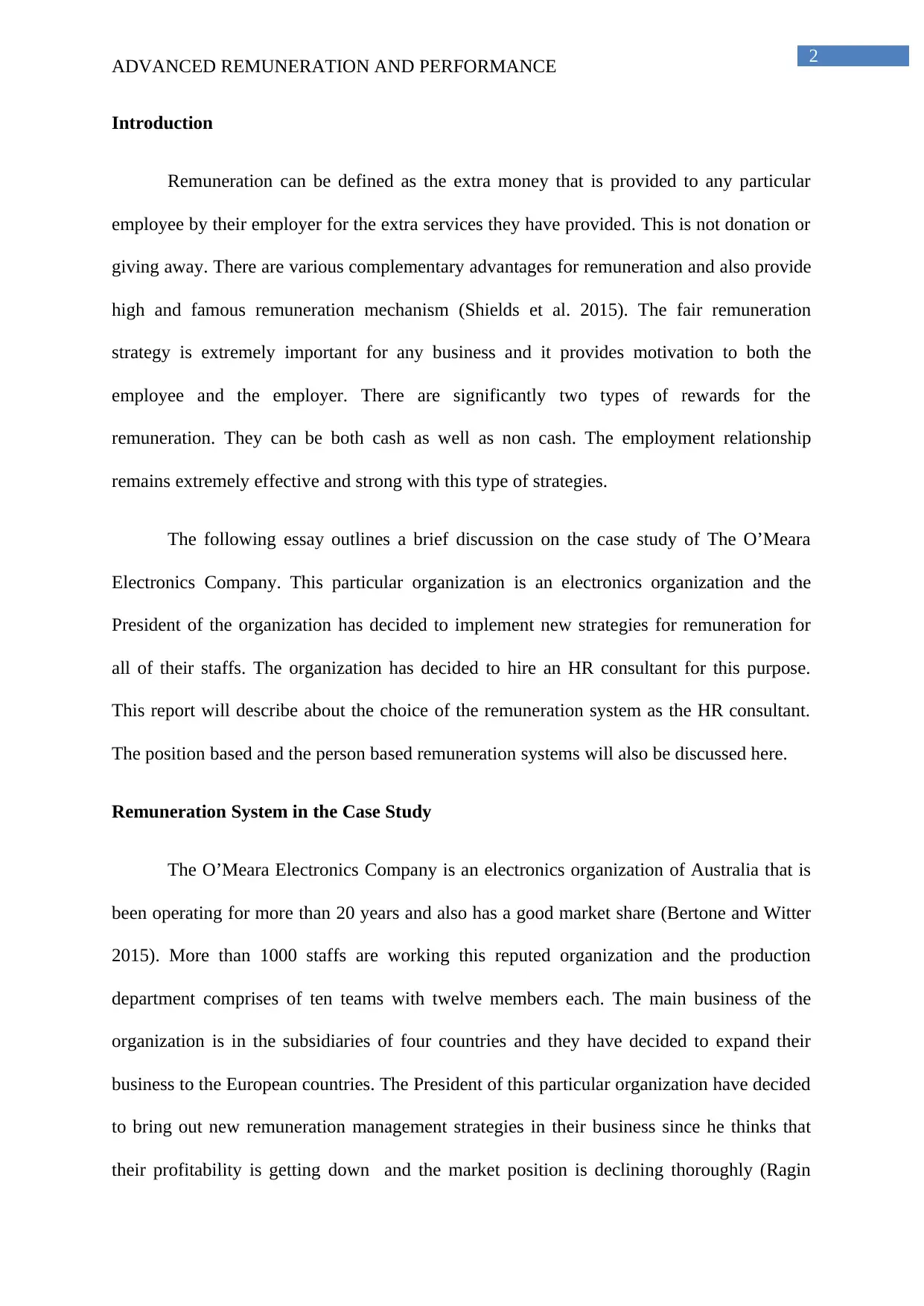
2
ADVANCED REMUNERATION AND PERFORMANCE
Introduction
Remuneration can be defined as the extra money that is provided to any particular
employee by their employer for the extra services they have provided. This is not donation or
giving away. There are various complementary advantages for remuneration and also provide
high and famous remuneration mechanism (Shields et al. 2015). The fair remuneration
strategy is extremely important for any business and it provides motivation to both the
employee and the employer. There are significantly two types of rewards for the
remuneration. They can be both cash as well as non cash. The employment relationship
remains extremely effective and strong with this type of strategies.
The following essay outlines a brief discussion on the case study of The O’Meara
Electronics Company. This particular organization is an electronics organization and the
President of the organization has decided to implement new strategies for remuneration for
all of their staffs. The organization has decided to hire an HR consultant for this purpose.
This report will describe about the choice of the remuneration system as the HR consultant.
The position based and the person based remuneration systems will also be discussed here.
Remuneration System in the Case Study
The O’Meara Electronics Company is an electronics organization of Australia that is
been operating for more than 20 years and also has a good market share (Bertone and Witter
2015). More than 1000 staffs are working this reputed organization and the production
department comprises of ten teams with twelve members each. The main business of the
organization is in the subsidiaries of four countries and they have decided to expand their
business to the European countries. The President of this particular organization have decided
to bring out new remuneration management strategies in their business since he thinks that
their profitability is getting down and the market position is declining thoroughly (Ragin
ADVANCED REMUNERATION AND PERFORMANCE
Introduction
Remuneration can be defined as the extra money that is provided to any particular
employee by their employer for the extra services they have provided. This is not donation or
giving away. There are various complementary advantages for remuneration and also provide
high and famous remuneration mechanism (Shields et al. 2015). The fair remuneration
strategy is extremely important for any business and it provides motivation to both the
employee and the employer. There are significantly two types of rewards for the
remuneration. They can be both cash as well as non cash. The employment relationship
remains extremely effective and strong with this type of strategies.
The following essay outlines a brief discussion on the case study of The O’Meara
Electronics Company. This particular organization is an electronics organization and the
President of the organization has decided to implement new strategies for remuneration for
all of their staffs. The organization has decided to hire an HR consultant for this purpose.
This report will describe about the choice of the remuneration system as the HR consultant.
The position based and the person based remuneration systems will also be discussed here.
Remuneration System in the Case Study
The O’Meara Electronics Company is an electronics organization of Australia that is
been operating for more than 20 years and also has a good market share (Bertone and Witter
2015). More than 1000 staffs are working this reputed organization and the production
department comprises of ten teams with twelve members each. The main business of the
organization is in the subsidiaries of four countries and they have decided to expand their
business to the European countries. The President of this particular organization have decided
to bring out new remuneration management strategies in their business since he thinks that
their profitability is getting down and the market position is declining thoroughly (Ragin

3
ADVANCED REMUNERATION AND PERFORMANCE
2014). Previously they have worked with the position-based remuneration strategy, however
now they have thought of person-based remuneration strategy. The forum of the Executive
Staff was eventually set up and all of the executive staffs attended. They decided to hire an
HR consultant for starting the person based strategy within the organization. They wanted to
develop a more systematic approach for identifying the issues and drawbacks that were
stopping them from reaching to the height of success (Ma, Pope and Xie 2014). This new
system would be helping the organization as well as all the employees. The system of
performance management was an all day forum and all staffs attended this forum. The major
organizational performance management is completely regarding customer contracts or
numbers and their approach is ad hoc (Bharadia et al. 2018). Each and every staff of the
organization performed the performance management system for the customers and finally
their performance was evaluated. The President mentioned that they had a zero tolerance
policy and whenever any faulty product was found, it directly impacted on the morale of the
staff and their performance. They decided to undertake different systems for rating and
feedback methods. Remuneration system was needed in this particular scenario, where the
employees, who would be performing really well, would be getting rewards for their jobs (C.
Harris and Daunt 2013). The employees would be extremely motivated in this case.
Position Based System
This is the most basic type of remuneration strategy that is undertaken by various
organizations. Position based system is also termed as the job based pay, where the extra
payment is made according to the position of the employee. For example if the person is the
chief executive officer of the organization, he would be getting much more pay than the
junior manager of that particular organization (Stachová, Stacho and Bartáková 2015). This is
known as the traditional structure of payment, where the jobs are always slotted into the
schedule of salary. Each and every position is solely assigned on a fixed range of
ADVANCED REMUNERATION AND PERFORMANCE
2014). Previously they have worked with the position-based remuneration strategy, however
now they have thought of person-based remuneration strategy. The forum of the Executive
Staff was eventually set up and all of the executive staffs attended. They decided to hire an
HR consultant for starting the person based strategy within the organization. They wanted to
develop a more systematic approach for identifying the issues and drawbacks that were
stopping them from reaching to the height of success (Ma, Pope and Xie 2014). This new
system would be helping the organization as well as all the employees. The system of
performance management was an all day forum and all staffs attended this forum. The major
organizational performance management is completely regarding customer contracts or
numbers and their approach is ad hoc (Bharadia et al. 2018). Each and every staff of the
organization performed the performance management system for the customers and finally
their performance was evaluated. The President mentioned that they had a zero tolerance
policy and whenever any faulty product was found, it directly impacted on the morale of the
staff and their performance. They decided to undertake different systems for rating and
feedback methods. Remuneration system was needed in this particular scenario, where the
employees, who would be performing really well, would be getting rewards for their jobs (C.
Harris and Daunt 2013). The employees would be extremely motivated in this case.
Position Based System
This is the most basic type of remuneration strategy that is undertaken by various
organizations. Position based system is also termed as the job based pay, where the extra
payment is made according to the position of the employee. For example if the person is the
chief executive officer of the organization, he would be getting much more pay than the
junior manager of that particular organization (Stachová, Stacho and Bartáková 2015). This is
known as the traditional structure of payment, where the jobs are always slotted into the
schedule of salary. Each and every position is solely assigned on a fixed range of
⊘ This is a preview!⊘
Do you want full access?
Subscribe today to unlock all pages.

Trusted by 1+ million students worldwide

4
ADVANCED REMUNERATION AND PERFORMANCE
remuneration and it also depends on the duties and responsibilities of the job. This type of
position based system eventually offers all the employees and staffs a predictive pay method
and thus making the entire system extremely easier (Kwenin, Muathe and Nzulwa 2013). The
reduction of discrimination in the pay scale is one of the most important advantages of the
position based system. The main problem with this particular system is that there is a little
room for the upward mobility payment. The employees of the organization, who do not have
any desire for promotion, get almost zero incentive for their work, even if they are working
really well. Frustration is again one of the major disadvantages in this type of position based
remuneration strategy (Terera and Ngirande 2014). The third important disadvantage of this
strategy is that it leads to major office politics as the employees feel that partiality is being
done with them.
The O’Meara Electronics Company previously had the system of position based
remuneration strategy in their organization. They used to pay their employees on the basis of
the position they are working and thus performance of the employees were not being
evaluated properly (Strohmeier 2013). This would again be brining frustration in the minds of
the workers and thus they thought of changing their strategy to the person based strategy.
Person Based System
The second type of remuneration strategy or system is the person based system. The
other name of this type of strategy is knowledge based, skills based or performance based
remuneration strategy. This is completely different form the position based system (Supanti,
Butcher and Fredline 2015). This type of remuneration strategy pays their employees, who
have set goals and objectives for learning new and innovative skills, acquired new
knowledge, performed really well and have gained utmost popularity amongst all of the
customers or clients. The self motivated and the ambitious employees usually prefer to go
ADVANCED REMUNERATION AND PERFORMANCE
remuneration and it also depends on the duties and responsibilities of the job. This type of
position based system eventually offers all the employees and staffs a predictive pay method
and thus making the entire system extremely easier (Kwenin, Muathe and Nzulwa 2013). The
reduction of discrimination in the pay scale is one of the most important advantages of the
position based system. The main problem with this particular system is that there is a little
room for the upward mobility payment. The employees of the organization, who do not have
any desire for promotion, get almost zero incentive for their work, even if they are working
really well. Frustration is again one of the major disadvantages in this type of position based
remuneration strategy (Terera and Ngirande 2014). The third important disadvantage of this
strategy is that it leads to major office politics as the employees feel that partiality is being
done with them.
The O’Meara Electronics Company previously had the system of position based
remuneration strategy in their organization. They used to pay their employees on the basis of
the position they are working and thus performance of the employees were not being
evaluated properly (Strohmeier 2013). This would again be brining frustration in the minds of
the workers and thus they thought of changing their strategy to the person based strategy.
Person Based System
The second type of remuneration strategy or system is the person based system. The
other name of this type of strategy is knowledge based, skills based or performance based
remuneration strategy. This is completely different form the position based system (Supanti,
Butcher and Fredline 2015). This type of remuneration strategy pays their employees, who
have set goals and objectives for learning new and innovative skills, acquired new
knowledge, performed really well and have gained utmost popularity amongst all of the
customers or clients. The self motivated and the ambitious employees usually prefer to go
Paraphrase This Document
Need a fresh take? Get an instant paraphrase of this document with our AI Paraphraser
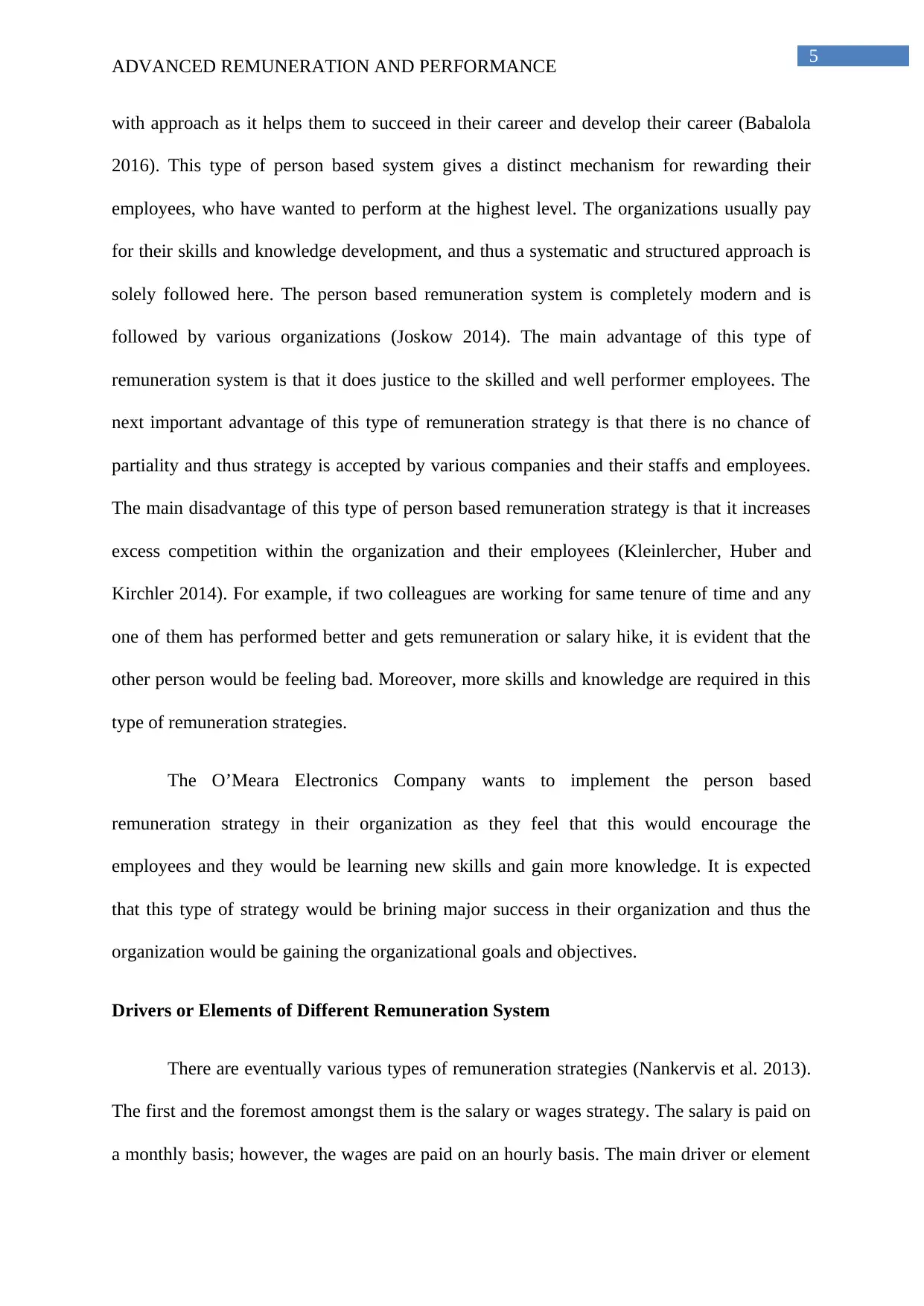
5
ADVANCED REMUNERATION AND PERFORMANCE
with approach as it helps them to succeed in their career and develop their career (Babalola
2016). This type of person based system gives a distinct mechanism for rewarding their
employees, who have wanted to perform at the highest level. The organizations usually pay
for their skills and knowledge development, and thus a systematic and structured approach is
solely followed here. The person based remuneration system is completely modern and is
followed by various organizations (Joskow 2014). The main advantage of this type of
remuneration system is that it does justice to the skilled and well performer employees. The
next important advantage of this type of remuneration strategy is that there is no chance of
partiality and thus strategy is accepted by various companies and their staffs and employees.
The main disadvantage of this type of person based remuneration strategy is that it increases
excess competition within the organization and their employees (Kleinlercher, Huber and
Kirchler 2014). For example, if two colleagues are working for same tenure of time and any
one of them has performed better and gets remuneration or salary hike, it is evident that the
other person would be feeling bad. Moreover, more skills and knowledge are required in this
type of remuneration strategies.
The O’Meara Electronics Company wants to implement the person based
remuneration strategy in their organization as they feel that this would encourage the
employees and they would be learning new skills and gain more knowledge. It is expected
that this type of strategy would be brining major success in their organization and thus the
organization would be gaining the organizational goals and objectives.
Drivers or Elements of Different Remuneration System
There are eventually various types of remuneration strategies (Nankervis et al. 2013).
The first and the foremost amongst them is the salary or wages strategy. The salary is paid on
a monthly basis; however, the wages are paid on an hourly basis. The main driver or element
ADVANCED REMUNERATION AND PERFORMANCE
with approach as it helps them to succeed in their career and develop their career (Babalola
2016). This type of person based system gives a distinct mechanism for rewarding their
employees, who have wanted to perform at the highest level. The organizations usually pay
for their skills and knowledge development, and thus a systematic and structured approach is
solely followed here. The person based remuneration system is completely modern and is
followed by various organizations (Joskow 2014). The main advantage of this type of
remuneration system is that it does justice to the skilled and well performer employees. The
next important advantage of this type of remuneration strategy is that there is no chance of
partiality and thus strategy is accepted by various companies and their staffs and employees.
The main disadvantage of this type of person based remuneration strategy is that it increases
excess competition within the organization and their employees (Kleinlercher, Huber and
Kirchler 2014). For example, if two colleagues are working for same tenure of time and any
one of them has performed better and gets remuneration or salary hike, it is evident that the
other person would be feeling bad. Moreover, more skills and knowledge are required in this
type of remuneration strategies.
The O’Meara Electronics Company wants to implement the person based
remuneration strategy in their organization as they feel that this would encourage the
employees and they would be learning new skills and gain more knowledge. It is expected
that this type of strategy would be brining major success in their organization and thus the
organization would be gaining the organizational goals and objectives.
Drivers or Elements of Different Remuneration System
There are eventually various types of remuneration strategies (Nankervis et al. 2013).
The first and the foremost amongst them is the salary or wages strategy. The salary is paid on
a monthly basis; however, the wages are paid on an hourly basis. The main driver or element
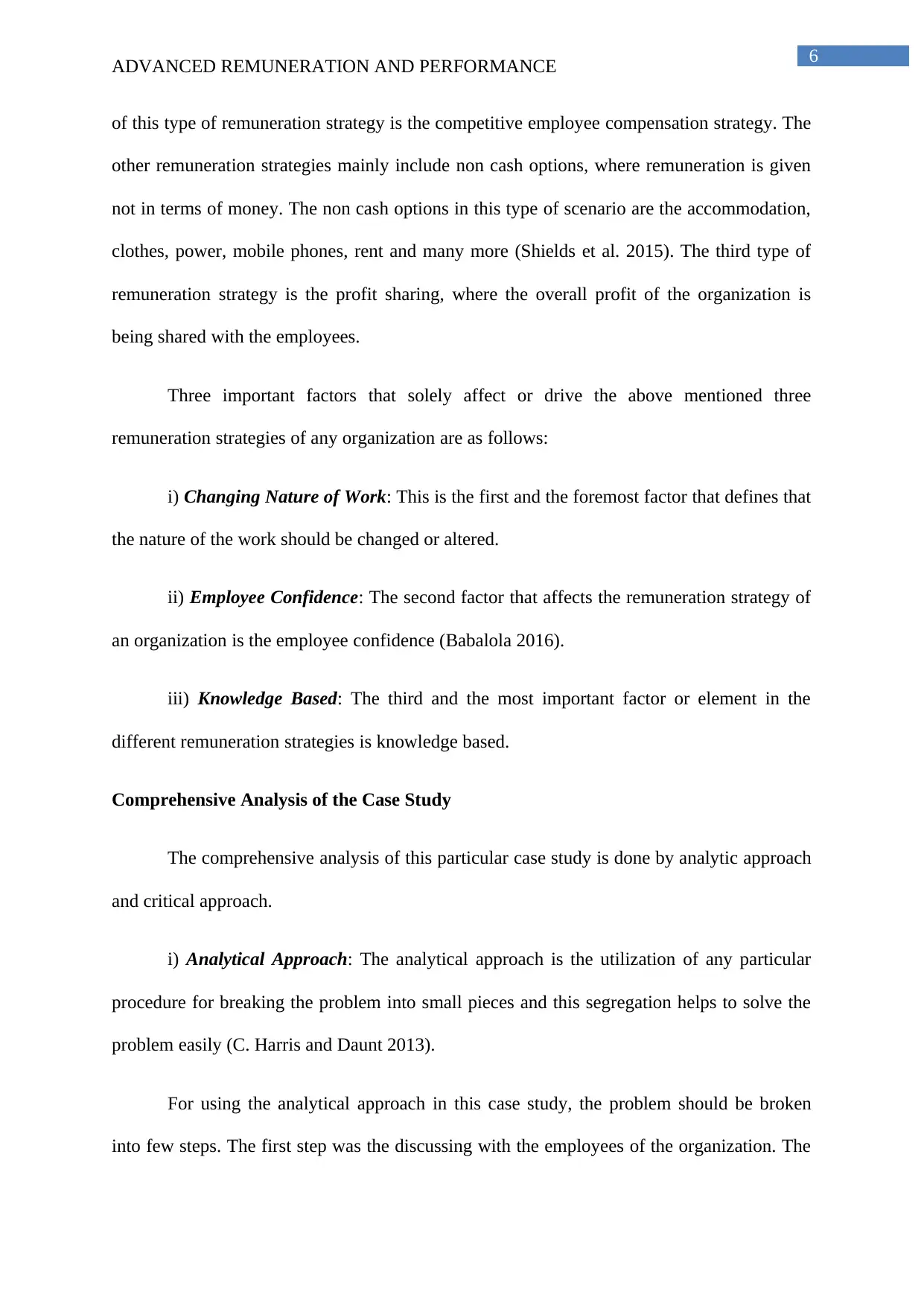
6
ADVANCED REMUNERATION AND PERFORMANCE
of this type of remuneration strategy is the competitive employee compensation strategy. The
other remuneration strategies mainly include non cash options, where remuneration is given
not in terms of money. The non cash options in this type of scenario are the accommodation,
clothes, power, mobile phones, rent and many more (Shields et al. 2015). The third type of
remuneration strategy is the profit sharing, where the overall profit of the organization is
being shared with the employees.
Three important factors that solely affect or drive the above mentioned three
remuneration strategies of any organization are as follows:
i) Changing Nature of Work: This is the first and the foremost factor that defines that
the nature of the work should be changed or altered.
ii) Employee Confidence: The second factor that affects the remuneration strategy of
an organization is the employee confidence (Babalola 2016).
iii) Knowledge Based: The third and the most important factor or element in the
different remuneration strategies is knowledge based.
Comprehensive Analysis of the Case Study
The comprehensive analysis of this particular case study is done by analytic approach
and critical approach.
i) Analytical Approach: The analytical approach is the utilization of any particular
procedure for breaking the problem into small pieces and this segregation helps to solve the
problem easily (C. Harris and Daunt 2013).
For using the analytical approach in this case study, the problem should be broken
into few steps. The first step was the discussing with the employees of the organization. The
ADVANCED REMUNERATION AND PERFORMANCE
of this type of remuneration strategy is the competitive employee compensation strategy. The
other remuneration strategies mainly include non cash options, where remuneration is given
not in terms of money. The non cash options in this type of scenario are the accommodation,
clothes, power, mobile phones, rent and many more (Shields et al. 2015). The third type of
remuneration strategy is the profit sharing, where the overall profit of the organization is
being shared with the employees.
Three important factors that solely affect or drive the above mentioned three
remuneration strategies of any organization are as follows:
i) Changing Nature of Work: This is the first and the foremost factor that defines that
the nature of the work should be changed or altered.
ii) Employee Confidence: The second factor that affects the remuneration strategy of
an organization is the employee confidence (Babalola 2016).
iii) Knowledge Based: The third and the most important factor or element in the
different remuneration strategies is knowledge based.
Comprehensive Analysis of the Case Study
The comprehensive analysis of this particular case study is done by analytic approach
and critical approach.
i) Analytical Approach: The analytical approach is the utilization of any particular
procedure for breaking the problem into small pieces and this segregation helps to solve the
problem easily (C. Harris and Daunt 2013).
For using the analytical approach in this case study, the problem should be broken
into few steps. The first step was the discussing with the employees of the organization. The
⊘ This is a preview!⊘
Do you want full access?
Subscribe today to unlock all pages.

Trusted by 1+ million students worldwide

7
ADVANCED REMUNERATION AND PERFORMANCE
second step was the performance evaluation management, where the skills of the employees
were evaluated in terms of various activities. The next activity is to evaluate the results of the
activities. The final step is to identify the best employees on the basis of their skills and thus
provide them remuneration.
ii) Critical Approach: The critical approach for analyzing any case study is to solve
by criticism. The case study could be criticized on the basis of criticizing the past
remuneration strategy of the organization (Awadh and Alyahya 2013). The position based
strategy was not bringing success to the organization and the customers were also not happy
with it. Thus, this type of traditional approach is required to be removed as soon as possible.
This critical approach to the case study would help it to understand the complete scenario
perfectly.
Recommendation for the Organization
The organization of The O’Meara Electronics Company has recruited an HR
consultant for solving their dilemma regarding remuneration strategies. Previously, they
utilized the position based strategy in their business for providing remuneration. However,
recently, they have decided to change their strategy to the person based strategy. The
remuneration strategy is not bringing success to the organization anymore and the shares of
this organization are going down drastically. This drastic downfall in the shares has brought a
major loss within the company and thus they have decided to motivate their employees after
identifying their skills and performance.
As the HR consultant of this reputed organization, after analyzing the complete case
study, the best recommendation to this Australian electronics company would be the mixture
of both person based and position based remuneration strategies. This type of remuneration
system or strategy is known as the hybrid system. This is the best strategy as it helps to
ADVANCED REMUNERATION AND PERFORMANCE
second step was the performance evaluation management, where the skills of the employees
were evaluated in terms of various activities. The next activity is to evaluate the results of the
activities. The final step is to identify the best employees on the basis of their skills and thus
provide them remuneration.
ii) Critical Approach: The critical approach for analyzing any case study is to solve
by criticism. The case study could be criticized on the basis of criticizing the past
remuneration strategy of the organization (Awadh and Alyahya 2013). The position based
strategy was not bringing success to the organization and the customers were also not happy
with it. Thus, this type of traditional approach is required to be removed as soon as possible.
This critical approach to the case study would help it to understand the complete scenario
perfectly.
Recommendation for the Organization
The organization of The O’Meara Electronics Company has recruited an HR
consultant for solving their dilemma regarding remuneration strategies. Previously, they
utilized the position based strategy in their business for providing remuneration. However,
recently, they have decided to change their strategy to the person based strategy. The
remuneration strategy is not bringing success to the organization anymore and the shares of
this organization are going down drastically. This drastic downfall in the shares has brought a
major loss within the company and thus they have decided to motivate their employees after
identifying their skills and performance.
As the HR consultant of this reputed organization, after analyzing the complete case
study, the best recommendation to this Australian electronics company would be the mixture
of both person based and position based remuneration strategies. This type of remuneration
system or strategy is known as the hybrid system. This is the best strategy as it helps to
Paraphrase This Document
Need a fresh take? Get an instant paraphrase of this document with our AI Paraphraser
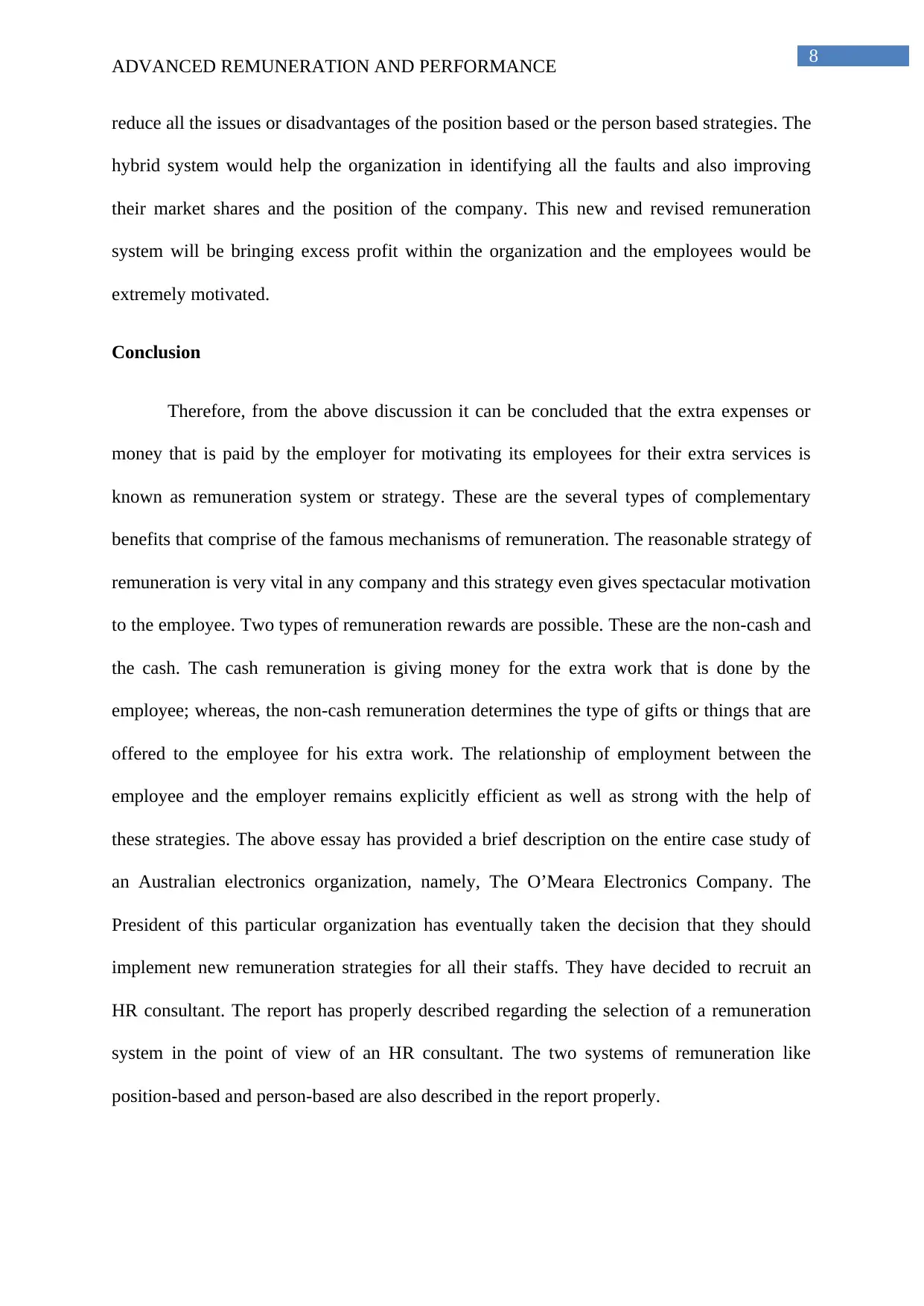
8
ADVANCED REMUNERATION AND PERFORMANCE
reduce all the issues or disadvantages of the position based or the person based strategies. The
hybrid system would help the organization in identifying all the faults and also improving
their market shares and the position of the company. This new and revised remuneration
system will be bringing excess profit within the organization and the employees would be
extremely motivated.
Conclusion
Therefore, from the above discussion it can be concluded that the extra expenses or
money that is paid by the employer for motivating its employees for their extra services is
known as remuneration system or strategy. These are the several types of complementary
benefits that comprise of the famous mechanisms of remuneration. The reasonable strategy of
remuneration is very vital in any company and this strategy even gives spectacular motivation
to the employee. Two types of remuneration rewards are possible. These are the non-cash and
the cash. The cash remuneration is giving money for the extra work that is done by the
employee; whereas, the non-cash remuneration determines the type of gifts or things that are
offered to the employee for his extra work. The relationship of employment between the
employee and the employer remains explicitly efficient as well as strong with the help of
these strategies. The above essay has provided a brief description on the entire case study of
an Australian electronics organization, namely, The O’Meara Electronics Company. The
President of this particular organization has eventually taken the decision that they should
implement new remuneration strategies for all their staffs. They have decided to recruit an
HR consultant. The report has properly described regarding the selection of a remuneration
system in the point of view of an HR consultant. The two systems of remuneration like
position-based and person-based are also described in the report properly.
ADVANCED REMUNERATION AND PERFORMANCE
reduce all the issues or disadvantages of the position based or the person based strategies. The
hybrid system would help the organization in identifying all the faults and also improving
their market shares and the position of the company. This new and revised remuneration
system will be bringing excess profit within the organization and the employees would be
extremely motivated.
Conclusion
Therefore, from the above discussion it can be concluded that the extra expenses or
money that is paid by the employer for motivating its employees for their extra services is
known as remuneration system or strategy. These are the several types of complementary
benefits that comprise of the famous mechanisms of remuneration. The reasonable strategy of
remuneration is very vital in any company and this strategy even gives spectacular motivation
to the employee. Two types of remuneration rewards are possible. These are the non-cash and
the cash. The cash remuneration is giving money for the extra work that is done by the
employee; whereas, the non-cash remuneration determines the type of gifts or things that are
offered to the employee for his extra work. The relationship of employment between the
employee and the employer remains explicitly efficient as well as strong with the help of
these strategies. The above essay has provided a brief description on the entire case study of
an Australian electronics organization, namely, The O’Meara Electronics Company. The
President of this particular organization has eventually taken the decision that they should
implement new remuneration strategies for all their staffs. They have decided to recruit an
HR consultant. The report has properly described regarding the selection of a remuneration
system in the point of view of an HR consultant. The two systems of remuneration like
position-based and person-based are also described in the report properly.
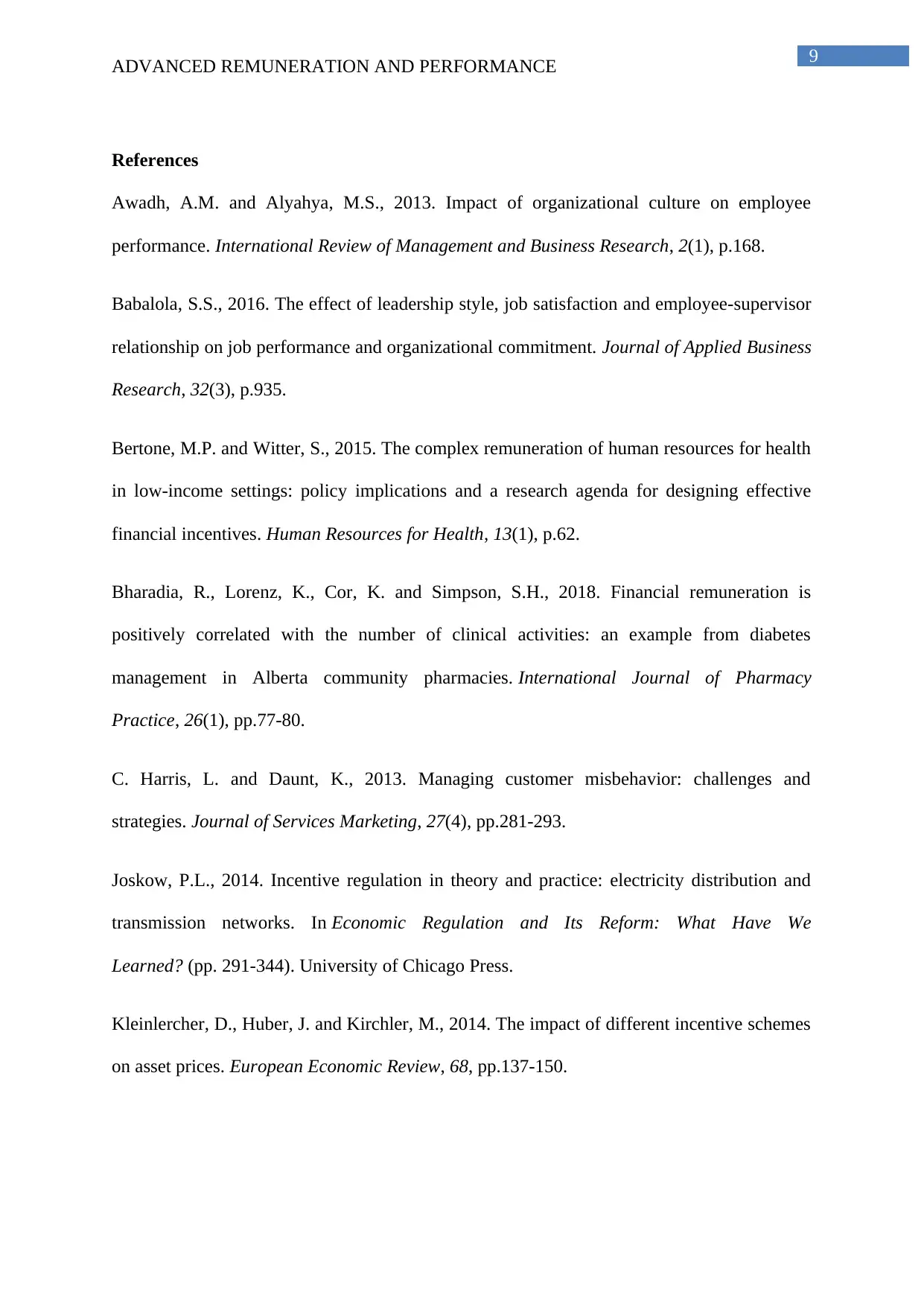
9
ADVANCED REMUNERATION AND PERFORMANCE
References
Awadh, A.M. and Alyahya, M.S., 2013. Impact of organizational culture on employee
performance. International Review of Management and Business Research, 2(1), p.168.
Babalola, S.S., 2016. The effect of leadership style, job satisfaction and employee-supervisor
relationship on job performance and organizational commitment. Journal of Applied Business
Research, 32(3), p.935.
Bertone, M.P. and Witter, S., 2015. The complex remuneration of human resources for health
in low-income settings: policy implications and a research agenda for designing effective
financial incentives. Human Resources for Health, 13(1), p.62.
Bharadia, R., Lorenz, K., Cor, K. and Simpson, S.H., 2018. Financial remuneration is
positively correlated with the number of clinical activities: an example from diabetes
management in Alberta community pharmacies. International Journal of Pharmacy
Practice, 26(1), pp.77-80.
C. Harris, L. and Daunt, K., 2013. Managing customer misbehavior: challenges and
strategies. Journal of Services Marketing, 27(4), pp.281-293.
Joskow, P.L., 2014. Incentive regulation in theory and practice: electricity distribution and
transmission networks. In Economic Regulation and Its Reform: What Have We
Learned? (pp. 291-344). University of Chicago Press.
Kleinlercher, D., Huber, J. and Kirchler, M., 2014. The impact of different incentive schemes
on asset prices. European Economic Review, 68, pp.137-150.
ADVANCED REMUNERATION AND PERFORMANCE
References
Awadh, A.M. and Alyahya, M.S., 2013. Impact of organizational culture on employee
performance. International Review of Management and Business Research, 2(1), p.168.
Babalola, S.S., 2016. The effect of leadership style, job satisfaction and employee-supervisor
relationship on job performance and organizational commitment. Journal of Applied Business
Research, 32(3), p.935.
Bertone, M.P. and Witter, S., 2015. The complex remuneration of human resources for health
in low-income settings: policy implications and a research agenda for designing effective
financial incentives. Human Resources for Health, 13(1), p.62.
Bharadia, R., Lorenz, K., Cor, K. and Simpson, S.H., 2018. Financial remuneration is
positively correlated with the number of clinical activities: an example from diabetes
management in Alberta community pharmacies. International Journal of Pharmacy
Practice, 26(1), pp.77-80.
C. Harris, L. and Daunt, K., 2013. Managing customer misbehavior: challenges and
strategies. Journal of Services Marketing, 27(4), pp.281-293.
Joskow, P.L., 2014. Incentive regulation in theory and practice: electricity distribution and
transmission networks. In Economic Regulation and Its Reform: What Have We
Learned? (pp. 291-344). University of Chicago Press.
Kleinlercher, D., Huber, J. and Kirchler, M., 2014. The impact of different incentive schemes
on asset prices. European Economic Review, 68, pp.137-150.
⊘ This is a preview!⊘
Do you want full access?
Subscribe today to unlock all pages.

Trusted by 1+ million students worldwide
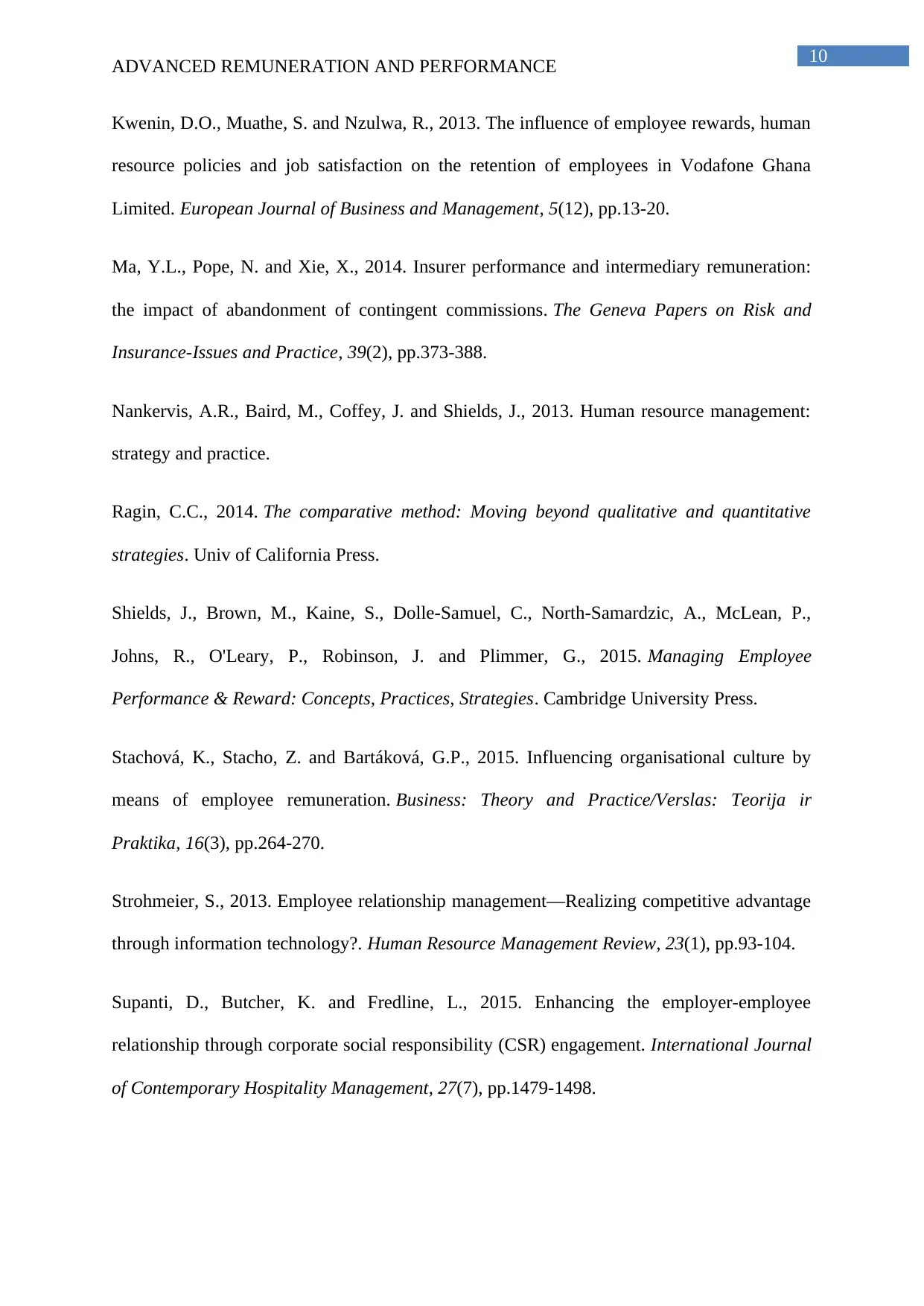
10
ADVANCED REMUNERATION AND PERFORMANCE
Kwenin, D.O., Muathe, S. and Nzulwa, R., 2013. The influence of employee rewards, human
resource policies and job satisfaction on the retention of employees in Vodafone Ghana
Limited. European Journal of Business and Management, 5(12), pp.13-20.
Ma, Y.L., Pope, N. and Xie, X., 2014. Insurer performance and intermediary remuneration:
the impact of abandonment of contingent commissions. The Geneva Papers on Risk and
Insurance-Issues and Practice, 39(2), pp.373-388.
Nankervis, A.R., Baird, M., Coffey, J. and Shields, J., 2013. Human resource management:
strategy and practice.
Ragin, C.C., 2014. The comparative method: Moving beyond qualitative and quantitative
strategies. Univ of California Press.
Shields, J., Brown, M., Kaine, S., Dolle-Samuel, C., North-Samardzic, A., McLean, P.,
Johns, R., O'Leary, P., Robinson, J. and Plimmer, G., 2015. Managing Employee
Performance & Reward: Concepts, Practices, Strategies. Cambridge University Press.
Stachová, K., Stacho, Z. and Bartáková, G.P., 2015. Influencing organisational culture by
means of employee remuneration. Business: Theory and Practice/Verslas: Teorija ir
Praktika, 16(3), pp.264-270.
Strohmeier, S., 2013. Employee relationship management—Realizing competitive advantage
through information technology?. Human Resource Management Review, 23(1), pp.93-104.
Supanti, D., Butcher, K. and Fredline, L., 2015. Enhancing the employer-employee
relationship through corporate social responsibility (CSR) engagement. International Journal
of Contemporary Hospitality Management, 27(7), pp.1479-1498.
ADVANCED REMUNERATION AND PERFORMANCE
Kwenin, D.O., Muathe, S. and Nzulwa, R., 2013. The influence of employee rewards, human
resource policies and job satisfaction on the retention of employees in Vodafone Ghana
Limited. European Journal of Business and Management, 5(12), pp.13-20.
Ma, Y.L., Pope, N. and Xie, X., 2014. Insurer performance and intermediary remuneration:
the impact of abandonment of contingent commissions. The Geneva Papers on Risk and
Insurance-Issues and Practice, 39(2), pp.373-388.
Nankervis, A.R., Baird, M., Coffey, J. and Shields, J., 2013. Human resource management:
strategy and practice.
Ragin, C.C., 2014. The comparative method: Moving beyond qualitative and quantitative
strategies. Univ of California Press.
Shields, J., Brown, M., Kaine, S., Dolle-Samuel, C., North-Samardzic, A., McLean, P.,
Johns, R., O'Leary, P., Robinson, J. and Plimmer, G., 2015. Managing Employee
Performance & Reward: Concepts, Practices, Strategies. Cambridge University Press.
Stachová, K., Stacho, Z. and Bartáková, G.P., 2015. Influencing organisational culture by
means of employee remuneration. Business: Theory and Practice/Verslas: Teorija ir
Praktika, 16(3), pp.264-270.
Strohmeier, S., 2013. Employee relationship management—Realizing competitive advantage
through information technology?. Human Resource Management Review, 23(1), pp.93-104.
Supanti, D., Butcher, K. and Fredline, L., 2015. Enhancing the employer-employee
relationship through corporate social responsibility (CSR) engagement. International Journal
of Contemporary Hospitality Management, 27(7), pp.1479-1498.
Paraphrase This Document
Need a fresh take? Get an instant paraphrase of this document with our AI Paraphraser

11
ADVANCED REMUNERATION AND PERFORMANCE
Terera, S.R. and Ngirande, H., 2014. The impact of rewards on job satisfaction and employee
retention. Mediterranean Journal of Social Sciences, 5(1), p.481.
ADVANCED REMUNERATION AND PERFORMANCE
Terera, S.R. and Ngirande, H., 2014. The impact of rewards on job satisfaction and employee
retention. Mediterranean Journal of Social Sciences, 5(1), p.481.
1 out of 11
Related Documents
Your All-in-One AI-Powered Toolkit for Academic Success.
+13062052269
info@desklib.com
Available 24*7 on WhatsApp / Email
![[object Object]](/_next/static/media/star-bottom.7253800d.svg)
Unlock your academic potential
Copyright © 2020–2025 A2Z Services. All Rights Reserved. Developed and managed by ZUCOL.





